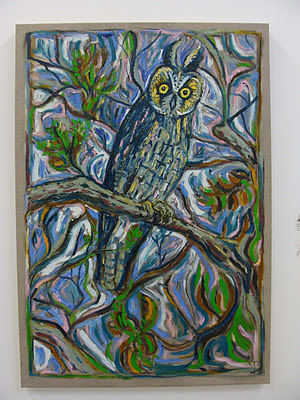I guess I've never really considered that art and conservation might make a good pair; that art could lead to a real, radical change in the way conservation is approached (and the public's awareness of it) I've stood and admired the work of Constable, Cole, Adams et al and marvelled at the depth of their landscapes, their unique and powerful interpretations of nature. But I find there is little connection with the present. The amazing Ghosts of Gone Birds exhibition was different and I was blown away when I made it along for the penultimate day last Monday.
Although Gone Birds, an art event inspired by BirdLife International's 'Preventing Extinctions' programme, primarily addressed bird species we have lost, it was undoubtedly about the here and now; the uncertain future faced by thousands of bird species. The works on display, submitted by a range of artists from across the world, using numerous forms of media, featured a bird that is now extinct. They were by turns colourful, odd, bleak and even amusing. But rather than dwell on nostalgia and what we've lost, each piece managed to establish a personal connection and a sense of something like...hope?
Combining art, music, design, debate and social media, the organisers have done an incredible job bringing this to life. Everything about the exhibition had been thought about carefully and I think it was a nice idea to allow photography throughout. They understand the need to share the mission and that pictures, paintings and photographs are a good way of doing that. Forget copyright, we've got bigger things to worry about. Here are some of my favourites:
 |
| Billy Childish - Reunion Owl, 2011 |
 |
| California Condor - amazing pencil sketch (apologies - I can't remember the artist) |
 |
| Guadalupe Caracara - Edwyn Collins, 2011 |
 |
| Charming Baker - One day our past will be all there is to look forward to, Oil on Canvas |
The final room in the makeshift gallery focused on a subject that is close to my heart - the tragic, senseless killing of migrating birds taking place in Malta every year. Spread out on the floor, marked in hazard tape was the shape of a bird. In the centre was a heap of spent bullet casings and surrounding this - dozens of photographs of shot birds. Wounded, dead; harriers, bee-eaters, wheatears, herons, storks, cuckoos and more. The photographs were taken 4 weeks ago when members of Gone Birds visited Malta.
As well as highlighting BirdLife's campaign there, this room was an example and a reminder - extinctions are not just a thing of the past, they are happening right now, across the world. Future extinctions. Out into the London cold several hours later I felt pretty drained, but in a way kind of energised. Gone Birds is a rallying cry to the horrors and injustices facing birds across our planet as estuarys are swallowed up, forests torn down, farmland raped and oceans plundered.
Although this exhibition has ended I hear there are plans for it to tour sometime. Perhaps opportunities to go international. Whatever, it's just the beginning. C'mon, get etching!
Links:
Ghosts of Gone Birds - @gonebirds - BirdLife International













